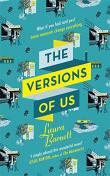BKMT READING GUIDES
The Versions of Us
by Laura Barnett
Hardcover : 0 pages
5 clubs reading this now
0 members have read this book
Introduction
What if you had said yes ...? Eva and Jim are nineteen, and students at Cambridge, when their paths first cross in 1958. Jim is walking along a lane when a woman approaching him on a bicycle swerves to avoid a dog. What happens next will determine the rest of their lives. We follow three different versions of their future - together, and apart - as their love story takes on different incarnations and twists and turns to the conclusion in the present day. The Versions of Us is an outstanding debut novel about the choices we make and the different paths that our lives might follow. What if one small decision could change the rest of your life?
Discussion Questions
1. The book opens with two scenes that take place in 1938. What do the two scenes share in common? How do they compare to the storylines between Eva and Jim that follow? What major themes of the novel are introduced in these opening sections?2. In Version 2: Algonquin, New York, November 1963, Eva realizes that her life has not gone as she had imagined it would. How has her life failed to match up to her expectations? Where else are Eva’s and Jim’s expectations challenged or upended in the novel?
3. In Version 3: Sandworms, Suffolk, October 1966, Miriam tells Eva that she can tell that Eva is not happy in her marriage. What advice does Miriam give her daughter? Do you think it is good advice? Does Eva accept Miriam’s advice or reject it?
4. In Version 3: Frost, Cornwall, October 1966, Jim says that “he is old enough to know happiness for what it is” (142). How does he believe happiness is defined and how does his idea of happiness in this chapter compare to other depictions of happiness throughout the book? Does the book seem to settle on any single definition of happiness? If so, how does the book suggest happiness can be attained?
5. In Version 3: Thirty, London, July 1971, David tells Eva that she should be writing and she replies, “It’s always simpler for a man” (166). Do you agree with her? Why or why not? What do the other versions of the story suggest about gender and the workplace or gender and success?
6. Explore presentations of marriage and love in the novel. How are each defined and depicted? What does Sinclair learn about marriage in Version 1 as he cares for Vivian? Does the book define what a “good” marriage entails or what the best kind of love is?
7. What is the role of art in the book? Which of the characters are artists and why do they undertake their artistic pursuits? What purpose do they find in their art? What obstacles do they face as artists? How does their artwork or role as artist shape and inform their identity?
8. The title of the novel is taken from the name of a triptych painted by Jim. What is the subject of the triptych and why is it significant both to Jim and to those who view it? How might it serve as a major symbol within the novel?
9. Thinking about the various settings of the novel, how do the times and places depicted in the novel mirror or help to reveal major themes of the story?
10. In Version 3: Afterglow, Los Angeles, December 1977, what does Eva say that she realizes about motherhood? What does she believe makes the best mother and why? Do you agree with her? What do the other versions of the story seem to suggest?
11. Evaluate the parent-child relationships presented in the book. What do the various relationships share in common? What do they reveal about parenthood when considered collectively? How are the characters in the book shaped and influenced by their own childhoods? How do the relationships they shared with their own parents influence and inform the way that they ultimately choose to raise and interact with their children?
12. What are some of the examples of infidelity in the novel? What causes or motivates the various characters to stray from their partners? How do these infidelities or betrayals impact their lives and the lives of those they are unfaithful to? Are any of the characters rewarded for seeking their own happiness?
13. Discuss how the book creates a dialogue around fate and accident versus choice. How much control do the characters have over their own lives and how much is left to chance?
14. Look at the structure of the novel. Why do you think the author chose to set up the novel in three sections? What themes does this structure help to reveal or reinforce? How would your understanding of the novel be different if Barnett had implemented a different structure—telling each story without division, for example?
15. The novel covers a large expanse of time and includes characters of several generations. Consider the similarities and differences between characters of different generations in the novel. How are Eva and Jim like their parents and how do they differ? What, if anything, remains consistent over the passage of time between generations? Does the novel suggest whether we are simply doomed to repeat the past, or does it suggest, rather, that there is room for change?
16. What kinds of loss are depicted in the book and how do the characters deal with these losses? Does the book offer any view of the best way to grieve or confront loss? Does anything positive seem to come from the characters’ processes of grieving?
17. How do the three final chapters work together as a cohesive ending? What final message or messages—or questions—do they seem to impart when considered collectively? Do the last three chapters draw the various pieces of the book into a unified whole or present three contradictory conclusions?
Weblinks
| » |
Official web site for the book
|
| » |
Author's web site
|
| » |
Publisher's Book Info
|
| » |
Follow the author on Twitter
|
Notes From the Author to the Bookclub
About the Author Laura Barnett is a novelist, short story writer, journalist, and theater critic. She was named one of the Observer’s New Faces of Fiction in 2015. She has written for the Daily Telegraph, the Guardian, and Time Out London and is the author of Advice from the Players, a compendium of advice for actors. Barnett’s debut novel, The Versions of Us, debuted in the UK in June 2015 and was an immediate bestseller. The book was named Waterstones’ Fiction Book of the Month for June 2015 and was chosen for the prestigious Richard and Judy Book Club and Waterstones’ Book Club in 2016.Book Club Recommendations
Recommended to book clubs by 0 of 0 members.
Book Club HQ to over 90,000+ book clubs and ready to welcome yours.
Get free weekly updates on top club picks, book giveaways, author events and more








